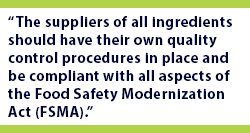
Does Your Calf Feed Come With the Quality You Expect?
 By Donovan Nelson, Vita Plus quality assurance and formulation specialist
By Donovan Nelson, Vita Plus quality assurance and formulation specialistQuality calf feeds can’t be made without quality ingredients and manufacturing processes. This includes a safe and consistent source of raw ingredients, regulatory compliance, and a strong feed mill quality assurance program.
Safe and high-quality ingredients
- Nutrient content: Nutrient content (i.e. crude protein, fat, etc.) in ingredients, such as corn, soybean meal, canola meal, or dry distillers grains, can vary significantly from one crop year to the next and from region to region. For this reason, major grain and protein ingredients should be assayed by the manufacturer on a scheduled basis to ensure formulation specifications continue to be met (and adjusted when they are not).
- Grain quality: Most calf feeds consist of a major grain component (corn, oats, etc.), so it’s important the manufacturer’s grain source is monitored for mycotoxins. As crop years vary, utilizing corn with good test weight and low foreign material is crucial to minimizing fines in texturized calf feeds.
- Safety, compliance and traceability: Your calf feed manufacturer should have a supplier and ingredient approval program. The suppliers of all ingredients should have their own quality control procedures in place and be compliant with all aspects of the Food Safety Modernization Act (FSMA). Manufacturers should have established specifications for each ingredient to ensure these specifications are adhered to by means of their own internal testing program or open communication with the supplier (certificate of analysis with each lot, etc.).
 Manufacturing quality pellets
Manufacturing quality pellets
Pellet quality is crucial to minimizing fines, reducing shrink, and ensuring good intakes of complete pelleted calf feed and texturized feed containing a pelleted concentrate. A pellet durability index (PDI) should be conducted on every batch of pellets to ensure the pellet will withstand further manufacturing, transportation to the farm and normal feeding practices. If a batch of pellets yields a lower PDI than desired, the manufacturer can evaluate equipment and/or review the formulation to determine how to improve the product.
Other manufacturing quality factors
Several other factors are essential to producing excellent calf feed, including:
- Mixer uniformity: A mixer uniformity test should be conducted for the calf feed mixer on a scheduled basis to ensure it produces a consistent feed. This test takes multiple samples from a batch of feed and determines how much a nutrient varies in total content among the samples. The ultimate goal is for each calf to receive the same nutrition in each pail of feed.
- Mixing times: Established mixing times should be closely followed as over-mixing can lead to excessive fines in texturized feeds.
- Scales and meters: All scales and liquid ingredient meters should be calibrated on a scheduled basis to ensure ingredients are added to each batch at the intended amounts. This accuracy and consistency are especially important in texturized feeds because too much liquid can cause poor flowability of bulk products, resulting in hang-ups in storage. On the contrary, too little liquid can result in dry, dusty feeds that are not pleasant to work with and may contain more visible fines. Extremes on either side of this spectrum have the potential to deter calf intakes.
- Medication records, dosage and dispersibility: A daily medication reconciliation should be conducted to ensure all batches of medicated feed contain the intended amount. It’s also important the manufacturer is using a concentration of medication that will go into the intended batch size at a high enough inclusion rate that it is evenly and uniformly dispersed – this should be validated through testing by the manufacturer. Inaccurate dosage or inconsistent dispersibility of any drug will result in poor efficacy at the calf level.
Like any successful calf raising program, consistent attention to the small details is crucial to making a quality product. Know your manufacturer and the protocols it has in place to produce the excellent calf feed your calves deserve.
| Category: |
Calf and heifer nutrition Equipment Starting Strong - Calf Care |

